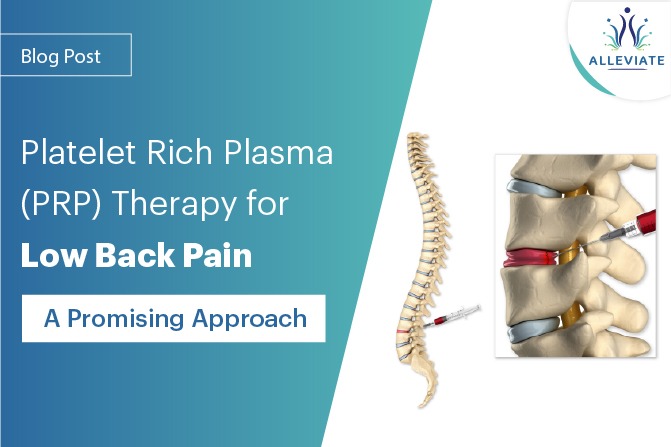Introduction
Low back pain is a prevalent and often debilitating condition that can significantly affect a person’s quality of life. Conventional treatments may provide temporary relief, but a growing interest in regenerative therapies like Platelet Rich Plasma (PRP) has emerged as a promising option for managing low back pain. In this article, we will delve into how PRP works, its role in treating sacroiliac joint pain and facet joint pain, the use of fluoroscopy in PRP injections, clinical results, and whether you might be a suitable candidate for PRP therapy.
How PRP Works: A Brief Overview
PRP therapy involves using a concentrated solution derived from the patient’s own blood, which is rich in platelets and growth factors. These components play a crucial role in the body’s natural healing processes. The therapy begins with drawing a small amount of blood, which is then processed to separate the platelets and growth factors from other blood components. The resulting PRP solution is then injected into the targeted area, promoting tissue regeneration, reducing inflammation, and potentially alleviating pain.
Role of PRP in Treating Sacroiliac Joint Pain and Facet Joint Pain
Sacroiliac joint pain and facet joint pain are common causes of low back pain. These conditions can arise from inflammation, degeneration, or instability in the joints. PRP therapy aims to address these issues by delivering a concentrated dose of growth factors directly to the affected area, stimulating tissue repair and reducing inflammation. Studies suggest that PRP injections may lead to improvements in pain, function, and overall quality of life for individuals with sacroiliac joint and facet joint pain.
Use of Fluoroscopy in PRP Injections for Low Back Pain
Fluoroscopy is a medical imaging technique that provides real-time X-ray guidance during procedures. In PRP injections for low back pain, fluoroscopy plays a crucial role in ensuring precise needle placement. This technique allows the healthcare provider to accurately target the specific area of pain, increasing the effectiveness of the treatment. Fluoroscopy-guided PRP injections provide a higher level of accuracy and safety, minimizing the risk of complications.
What to Expect and Clinical Results
Before undergoing PRP therapy for low back pain, a thorough evaluation by a qualified healthcare provider is essential. During the procedure, the patient’s blood is drawn, processed, and the PRP solution is injected into the targeted area using fluoroscopy guidance. While the injection itself might cause mild discomfort, patients typically experience minimal downtime and can resume their daily activities soon after the procedure.
Clinical results of PRP therapy for low back pain have shown promising outcomes. Patients who have undergone PRP injections often report a reduction in pain intensity, improved mobility, and enhanced overall well-being. While individual responses may vary, studies indicate that a significant number of patients experience positive results from PRP therapy for low back pain.
Am I a Good Candidate for PRP?
Determining whether you are a suitable candidate for PRP therapy involves a comprehensive evaluation by a healthcare provider. Factors such as your medical history, the underlying cause of your low back pain, and the severity of your condition will be taken into consideration. PRP therapy is generally considered for individuals who have not experienced satisfactory relief from conservative treatments. Consulting a healthcare professional will help you understand if PRP therapy is the right option for you.
Conclusion
As ardent practitioners of Regenerative Medicine AT ALLEVIATE, we can confidently say that Platelet Rich Plasma (PRP) therapy offers a promising avenue for managing low back pain, particularly in cases of sacroiliac joint pain and facet joint pain. The use of fluoroscopy-guided injections enhances the precision and effectiveness of the treatment. Clinical results indicate that PRP therapy can lead to notable improvements in pain and function for individuals struggling with low back pain. If you’re seeking an innovative and regenerative approach to address your low back pain, consulting a qualified healthcare provider will help determine if PRP therapy is a suitable choice for your specific condition.
References
- Anitua E, Andia I, Ardanza B, Nurden P, Nurden AT. Autologous platelets as a source of proteins for healing and tissue regeneration. Thrombosis and Haemostasis. 2004; 91(01): 4-15.
- Fredman R, Timms A, Betz R. Platelet-rich plasma for sacroiliac joint pain. The Spine Journal. 2004; 4(2): 643-8.
- Manchikanti L, Cash K, Pampati V, Falco FJ. Transforaminal epidural injections with Particulate vs Nonparticulate corticosteroids for lumbar radicular pain: A systematic review of 62 randomized controlled trials. Pain Physician. 2017; 20(4): E499-E524.
- Mishra A, Harmon K, Woodall J, Vieira A. Sports medicine applications of platelet rich plasma. Current Pharmaceutical Biotechnology. 2012; 13(7): 1185-95.





